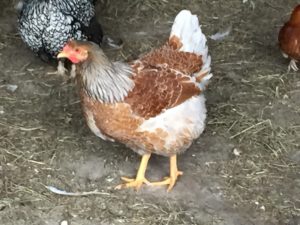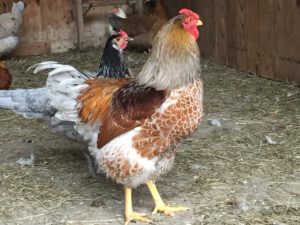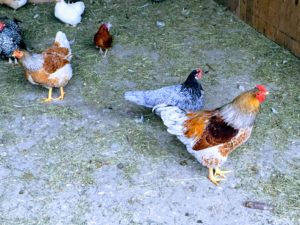As previously mentioned, one of the baby chicks had a different color pattern than the others.
The blue-laced red wyandotte hens normally look like the following:
The oddly-colored chick, however, eventually ended up growing up to look like:
Why so different? That’s because it’s a rooster!
Even though we ordered only hens, determining the sex of baby chicks is a very difficult to do 100% accurately and there is often an error rate of around at least 10%. In our case, we had ordered 6 hens but ended up with 1 rooster and 5 hens for an error rate around 17%.
The rooster is already ~30% larger than the hens and seems to still be growing. He has started crowing a little. He has not show any aggression toward us or the other rooster yet.
Generally, a flock can support about 1 rooster for every 10 to 15 hens without problems. Fewer hens than that can lead to fighting between the roosters for control of the flock. We now have 20 hens and 2 roosters. So far, the new rooster has effectively split the main flock with Pineapple, our older bantam rooster. The new rooster hangs out mainly with the 5 hens he grew up with and a couple others from the flock while Pineapple hangs out with the rest.




Do you have to be careful so that the roosters don’t spike you with their spurs?
Yes – roosters can be aggressive towards people and can do some serious harm with their spurs and flying kicks, especially to children and strangers.
So far, the new rooster respects us and hasn’t tried to attack us – he hasn’t fully matured yet though which is when his flock protection instinct really kicks in.
You can remove their spurs (they will eventually grow back) and we might try spur removal if he starts to show real aggression towards us.